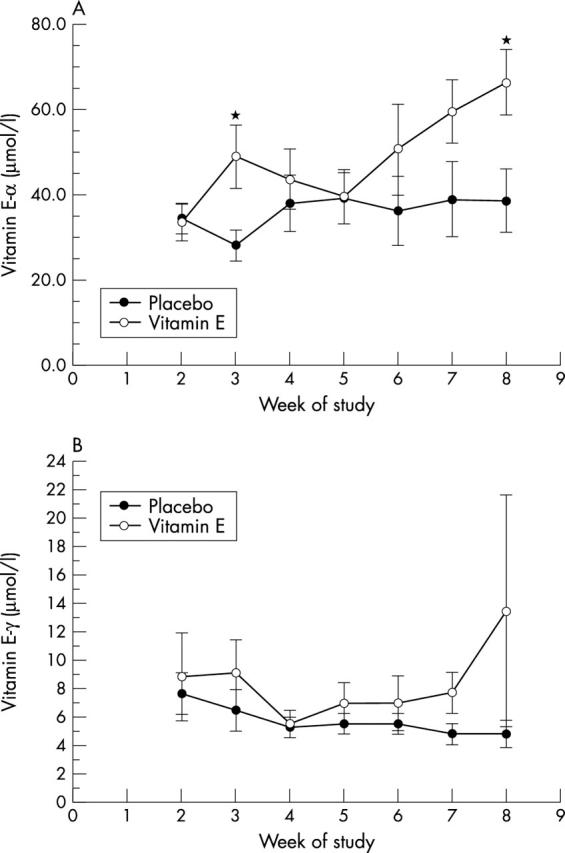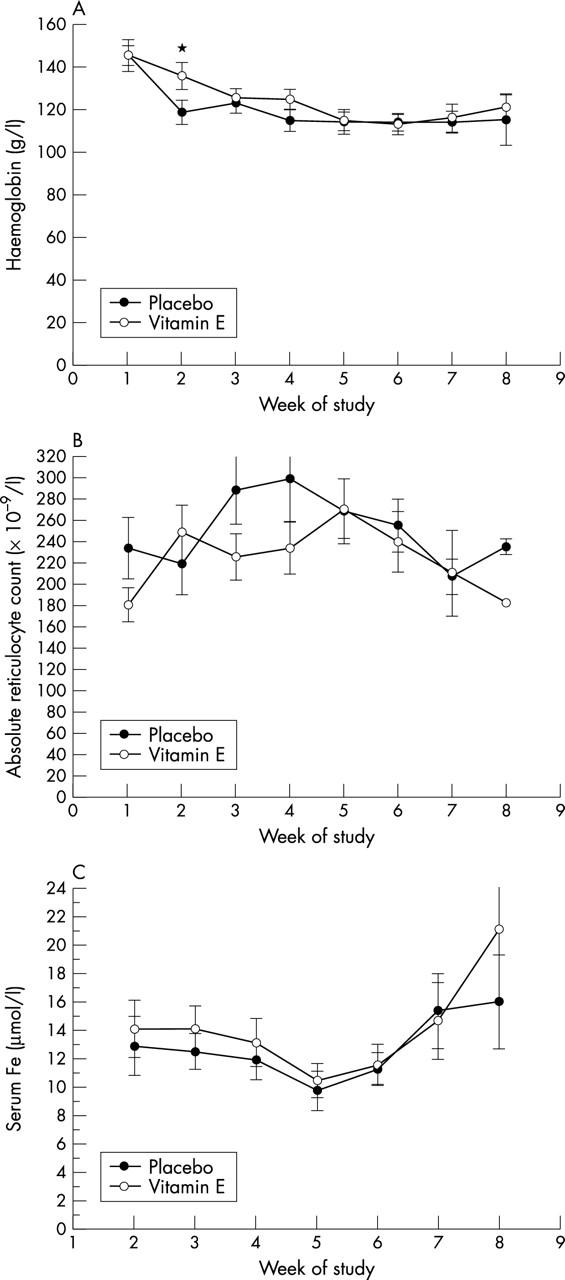Abstract
Aims: To evaluate the effects of vitamin E supplementation on haemoglobin concentration and the requirement for transfusion in premature infants treated with erythropoietin and iron.
Methods: Randomised, double blind, placebo controlled trial. Thirty infants ≤32 weeks gestation and ≤1250 g birth weight, who were defined as stable based on minimal requirements for respiratory support and phlebotomy, and absence of major congenital anomalies were enrolled. All were treated with erythropoietin and iron, and were randomised to receive, in addition, either vitamin E 50 IU/day or placebo for eight weeks or until discharge, whichever came first.
Results: Despite higher vitamin E (α-tocopherol) levels in the experimental group in weeks 3 (49.0 v 28.1 µmol/l) and 8 (66.2 v 38.5 µmol/l), there were no differences in haemoglobin, reticulocyte count, iron concentration, or transfusion requirement.
Conclusions: Oral vitamin E supplementation at 50 IU/day does not increase the response of preterm infants to erythropoietin and iron. Vitamin E obtained through standard nutrition may have been sufficient or higher doses may be required.
Full Text
The Full Text of this article is available as a PDF (206.9 KB).
Figure 1 .

Effects of vitamin E on serum vitamin E levels. Serum levels of α-tocopherol (A) and γ-tocopherol (B) were measured over time (weeks) and expressed as mean (SEM). *p < 0.05 versus placebo.
Figure 2 .

Effects of vitamin E on haematological measurements. Haemoglobin concentrations (A), reticulocyte counts (B), and serum iron concentrations (C) were measured over time (weeks) and expressed as mean (SEM). *p < 0.05 versus placebo.
Selected References
These references are in PubMed. This may not be the complete list of references from this article.
- Bieri J. G., Tolliver T. J., Catignani G. L. Simultaneous determination of alpha-tocopherol and retinol in plasma or red cells by high pressure liquid chromatography. Am J Clin Nutr. 1979 Oct;32(10):2143–2149. doi: 10.1093/ajcn/32.10.2143. [DOI] [PubMed] [Google Scholar]
- Brown M. S., Garcia J. F., Phibbs R. H., Dallman P. R. Decreased response of plasma immunoreactive erythropoietin to "available oxygen" in anemia of prematurity. J Pediatr. 1984 Nov;105(5):793–798. doi: 10.1016/s0022-3476(84)80309-1. [DOI] [PubMed] [Google Scholar]
- Brown M. S., Keith J. F., 3rd Comparison between two and five doses a week of recombinant human erythropoietin for anemia of prematurity: a randomized trial. Pediatrics. 1999 Aug;104(2 Pt 1):210–215. doi: 10.1542/peds.104.2.210. [DOI] [PubMed] [Google Scholar]
- Brown M. S., Shapiro H. Effect of protein intake on erythropoiesis during erythropoietin treatment of anemia of prematurity. J Pediatr. 1996 Apr;128(4):512–517. doi: 10.1016/s0022-3476(96)70362-1. [DOI] [PubMed] [Google Scholar]
- Cachia O., Léger C. L., Boulot P., Vernet M. H., Michel F., Crastes de Paulet A., Descomps B. Red blood cell vitamin E concentrations in fetuses are related to but lower than those in mothers during gestation. A possible association with maternal lipoprotein (a) plasma levels. Am J Obstet Gynecol. 1995 Jul;173(1):42–51. doi: 10.1016/0002-9378(95)90167-1. [DOI] [PubMed] [Google Scholar]
- Carter P. Spectrophotometric determination of serum iron at the submicrogram level with a new reagent (ferrozine). Anal Biochem. 1971 Apr;40(2):450–458. doi: 10.1016/0003-2697(71)90405-2. [DOI] [PubMed] [Google Scholar]
- Desai I. D., Martinez F. E., Dos Santos J. E., Dutra de Oliveria J. E. Transient lipoprotein deficiency at birth: a cause of low levels of vitamin E in the newborn. Acta Vitaminol Enzymol. 1984;6(2):71–76. [PubMed] [Google Scholar]
- Donato H., Vain N., Rendo P., Vivas N., Prudent L., Larguía M., Digregorio J., Vecchiarelli C., Valverde R., García C. Effect of early versus late administration of human recombinant erythropoietin on transfusion requirements in premature infants: results of a randomized, placebo-controlled, multicenter trial. Pediatrics. 2000 May;105(5):1066–1072. doi: 10.1542/peds.105.5.1066. [DOI] [PubMed] [Google Scholar]
- Farrell P. M. Vitamin E deficiency in premature infants. J Pediatr. 1979 Nov;95(5 Pt 2):869–872. doi: 10.1016/s0022-3476(79)80456-4. [DOI] [PubMed] [Google Scholar]
- Jain S. K. The neonatal erythrocyte and its oxidative susceptibility. Semin Hematol. 1989 Oct;26(4):286–300. [PubMed] [Google Scholar]
- Jain S. K., Wise R., Bocchini J. J., Jr Vitamin E and vitamin E-quinone levels in red blood cells and plasma of newborn infants and their mothers. J Am Coll Nutr. 1996 Feb;15(1):44–48. doi: 10.1080/07315724.1996.10718563. [DOI] [PubMed] [Google Scholar]
- Jansson L., Holmberg L., Nilsson B., Johansson B. Vitamin E requirements of preterm infants. Acta Paediatr Scand. 1978 Jul;67(4):459–463. doi: 10.1111/j.1651-2227.1978.tb16354.x. [DOI] [PubMed] [Google Scholar]
- Johnson L., Bowen F. W., Jr, Abbasi S., Herrmann N., Weston M., Sacks L., Porat R., Stahl G., Peckham G., Delivoria-Papadopoulos M. Relationship of prolonged pharmacologic serum levels of vitamin E to incidence of sepsis and necrotizing enterocolitis in infants with birth weight 1,500 grams or less. Pediatrics. 1985 Apr;75(4):619–638. [PubMed] [Google Scholar]
- Kling P. J., Schmidt R. L., Roberts R. A., Widness J. A. Serum erythropoietin levels during infancy: associations with erythropoiesis. J Pediatr. 1996 Jun;128(6):791–796. doi: 10.1016/s0022-3476(96)70331-1. [DOI] [PubMed] [Google Scholar]
- Kumar P., Shankaran S., Krishnan R. G. Recombinant human erythropoietin therapy for treatment of anemia of prematurity in very low birth weight infants: a randomized, double-blind, placebo-controlled trial. J Perinatol. 1998 May-Jun;18(3):173–177. [PubMed] [Google Scholar]
- Maier R. F., Obladen M., Kattner E., Natzschka J., Messer J., Regazzoni B. M., Speer C. P., Fellman V., Grauel E. L., Groneck P. High-versus low-dose erythropoietin in extremely low birth weight infants. The European Multicenter rhEPO Study Group. J Pediatr. 1998 May;132(5):866–870. doi: 10.1016/s0022-3476(98)70320-8. [DOI] [PubMed] [Google Scholar]
- Melhorn D. K., Gross S. Vitamin E-dependent anemia in the premature infant. I. Effects of large doses of medicinal iron. J Pediatr. 1971 Oct;79(4):569–580. doi: 10.1016/s0022-3476(71)80302-5. [DOI] [PubMed] [Google Scholar]
- Melhorn D. K., Gross S. Vitamin E-dependent anemia in the premature infant. I. Effects of large doses of medicinal iron. J Pediatr. 1971 Oct;79(4):569–580. doi: 10.1016/s0022-3476(71)80302-5. [DOI] [PubMed] [Google Scholar]
- Messer J., Haddad J., Donato L., Astruc D., Matis J. Early treatment of premature infants with recombinant human erythropoietin. Pediatrics. 1993 Oct;92(4):519–523. [PubMed] [Google Scholar]
- Meyer M. P., Haworth C., Meyer J. H., Commerford A. A comparison of oral and intravenous iron supplementation in preterm infants receiving recombinant erythropoietin. J Pediatr. 1996 Aug;129(2):258–263. doi: 10.1016/s0022-3476(96)70251-2. [DOI] [PubMed] [Google Scholar]
- Ohls R. K., Harcum J., Schibler K. R., Christensen R. D. The effect of erythropoietin on the transfusion requirements of preterm infants weighing 750 grams or less: a randomized, double-blind, placebo-controlled study. J Pediatr. 1997 Nov;131(5):661–665. doi: 10.1016/s0022-3476(97)70089-1. [DOI] [PubMed] [Google Scholar]
- Ohls R. K. The use of erythropoietin in neonates. Clin Perinatol. 2000 Sep;27(3):681–696. doi: 10.1016/s0095-5108(05)70045-2. [DOI] [PubMed] [Google Scholar]
- Shannon K. M., Keith J. F., 3rd, Mentzer W. C., Ehrenkranz R. A., Brown M. S., Widness J. A., Gleason C. A., Bifano E. M., Millard D. D., Davis C. B. Recombinant human erythropoietin stimulates erythropoiesis and reduces erythrocyte transfusions in very low birth weight preterm infants. Pediatrics. 1995 Jan;95(1):1–8. [PubMed] [Google Scholar]
- Stockman J. A., 3rd, Garcia J. F., Oski F. A. The anemia of prematurity. Factors governing the erythropoietin response. N Engl J Med. 1977 Mar 24;296(12):647–650. doi: 10.1056/NEJM197703242961202. [DOI] [PubMed] [Google Scholar]
- Stockman J. A., 3rd, Graeber J. E., Clark D. A., McClellan K., Garcia J. F., Kavey R. E. Anemia of prematurity: determinants of the erythropoietin response. J Pediatr. 1984 Nov;105(5):786–792. doi: 10.1016/s0022-3476(84)80308-x. [DOI] [PubMed] [Google Scholar]
- WRIGHT S. W., FILER L. J., Jr, MASON K. E. Vitamin E blood levels in premature and full term infants. Pediatrics. 1951 Mar;7(3):386–393. [PubMed] [Google Scholar]
- Williams M. L., Shoot R. J., O'Neal P. L., Oski F. A. Role of dietary iron and fat on vitamin E deficiency anemia of infancy. N Engl J Med. 1975 Apr 24;292(17):887–890. doi: 10.1056/NEJM197504242921704. [DOI] [PubMed] [Google Scholar]
- Zipursky A., Brown E. J., Watts J., Milner R., Rand C., Blanchette V. S., Bell E. F., Paes B., Ling E. Oral vitamin E supplementation for the prevention of anemia in premature infants: a controlled trial. Pediatrics. 1987 Jan;79(1):61–68. [PubMed] [Google Scholar]


